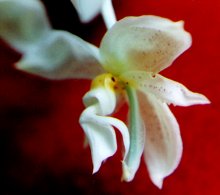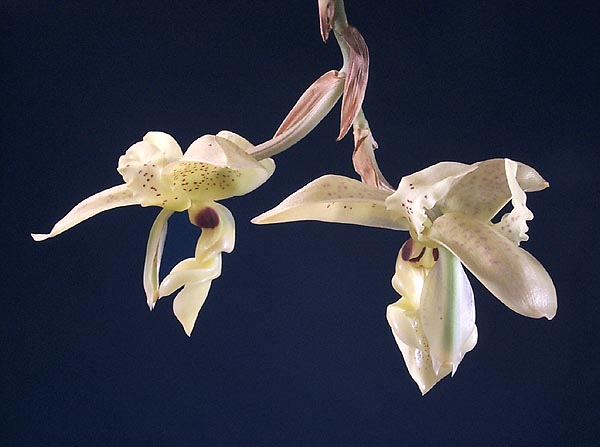
Native to Costa Rica and Nicaragua
Edited 10 May 2007
© Nina Rach

Stanhopea gibbosa Rchb.f.
Original publication: Gardener's Chronicle (1869) 1254.
This species has large, fragrant flowers on pendent inflorescences. The sepals and petals are cream to yellowish-white, while the lip (hypochile, mesochile, epichile) are pink, greenish-white, and cream. The pink coloration is a distinguishing characteristic. The lip is approx. 5 cm, and the underside of the hypochile is shallowly bilobed. The flowers also have fine spots on sepals, petals, and lip, and always has dark "eyes" on the petals and hypochile.
Top left photo by Rodolfo Baca. .
Stanhopea gibbosa is often confused with Stanhopea costaricensis, warcewicziana, warddii. However, note that S. gibbosa has eyes on the petals and on the hypochile, while S. costaricensis has no eyes, and S. warscewicziana and S. wardii each have eyes on the hypochile but NOT on the petals.
Photo at right depicts awarded clone Stanhopea gibbosa 'Milena' CHM/AOS
. . .
Photo at left provided by Greg Allikas (
Orchid Photo Page). This is the first bloom of his plant in October 2000. It grows in a 6" teak basket lined with sphagnum in southern Florida. . .
Stanhopea gibbosa 'Milena' CHM/AOS
Printed References:
Kenneth J. Curry, Lorraine M. McDowell, Walter S. Judd, & William Louis Stern (May 1991) "Osmophores, Floral Features, and Systematics of Stanhopea (Orchidaceae)," in: American Journal of Botany 78(5): 610-623.
"The floral fragrance glands (osmophores) of 18 species of Stanhopea and Sievekingia were examined through a series of developmental studies at light and electron microscope levels including late bud stages through postanthesis." [Sievekingia; Stanhopea anfracta, annulata, candida, ecornuta, gibbosa, martiana, oculata, pulla, radiosa, ruckeri, saccata, shuttleworthii, tigrina, vasquezii, and wardii]
Link to abstract:
http://www.botany.org/ajb/00029122_di001922.php
Robert L. Dressler (1993a) Phylogeny and Classification of the Orchid Family. Portland: Dioscorides Press, 314pp. [Plate 8: color photo of Stanhopea gibbosa from Costa Rica]
Robert L. Dressler (1993b) Field Guide to the Orchids of Costa Rica and Panama. Ithaca: Cornell University Press, 304 pp, 240 illustrations. [pg. 154: Stanhopea gibbosa]
Guenther Gerlach (1999) "80. Subtribus: Stanhopeinae und 81. Subtribus: Coeliopsidinae (Teil 1)," in: Schlechter, Die Orchideen, Band I, Teil C, Lieferung 37/38, 128 p. with 142 B&W illustrations, in German [854. Stanhopea, pp. 2429-2431].
Maria Isabel González & Dora E. Mora de Retana. 1996.
"El color de las flores en la taxonomía de cuatro especies de Stanhopea (Orchidaceae)" ["The color of the flowers in the taxonomy of four species of Stanhopea (Orchidaceae)"]. In: Revista Biol. Trop. 44: 525-539.
Fritz Hamer 1982. Orquídeas de Nicaragua. In: Icones Plantarum Tropicarum. Fascicle 12, Part 5, Plates 1179-1186. The Marie Selby Botanical Gardens. Sarasota, Florida.
Dora E. Mora & Maria Isabel González 1993.
"Variabilidad floral de cuatro especies de Stanhopea (Orchidaceae)". In: Revista de Biología Tropical.
E. Valerio 1972. La sistemática de Stanhopea. In: Orquídea 2:259-267.
Web References:
International Plant Names Index [IPNI],
www.ipni.org
Kate Burroughs' plant:
Photo by Jim Kennedy
Photo on Akerne Orchids' website: Stanhopea gibbosa from Ecuador.



-- A statistical analysis of floral colorss in four spp. of Stanhopea occurring in Costa Rica results in refined characterizations. A key (based mainly on flower colors) is provided to distinguish the spp. studied (Stanhopea costaricensis Rchb. f., S. gibbosa Rchb. f., S. wardii Lodd. ex Lindl., and S. warscewicziana Klotzsch).
